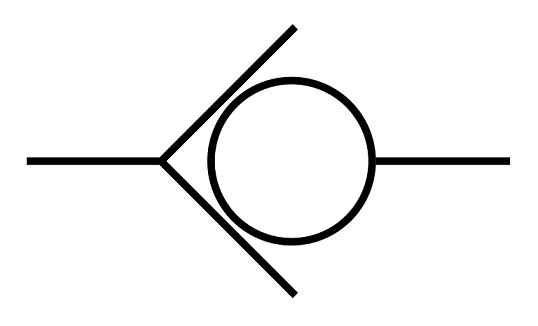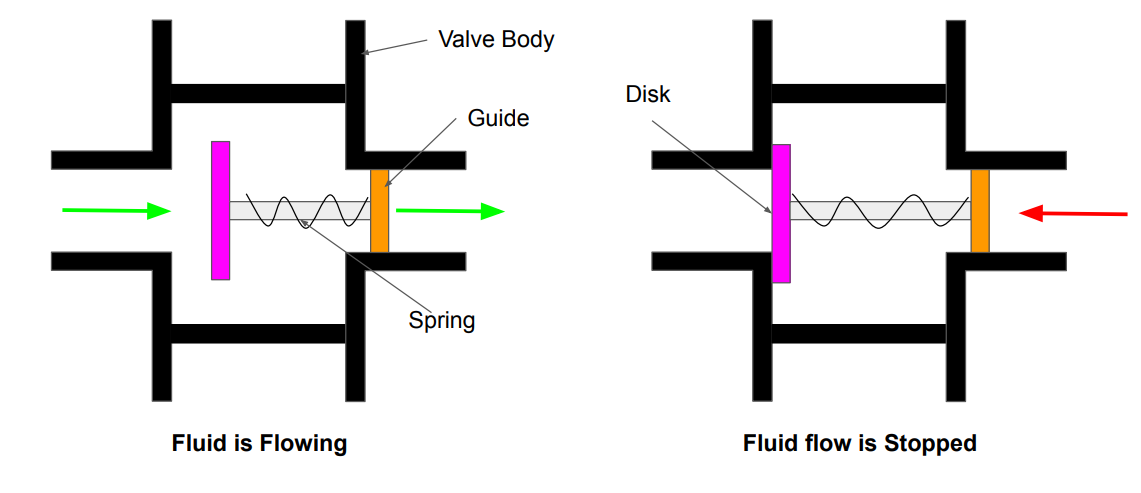The check valve is a type of valve that has an application to prevent the backflow of water in a piping system. Different types of check valves available in the market have different applications. This article covers various check valve types, their working, and their applications. API: American Petroleum Institute has defined the standards for Check Valves.
What is a Check Valve?
A Check valve is a type of non-return valve that only allows fluid to flow only in one direction. As a result they prevent backflow of the fluid.
Most check valves work automatically. Minimum differential upstream pressure is required to operate the check valve automatically, and this pressure is known as cracking pressure. The valve gets closed when the pressure differential is less than the specified cracking pressure.
Check Valve Symbol

Materials
- Brass
- Stainless Steel
- PVC (Polyvinyl Chloride)
- PP (Polypropylene)
How does a Check Valve work?
Check valve works on the principle of the pressure difference between the inlet and outlet port. The fluid starts flowing if the pressure difference between the inlet and outlet is greater than the cracking pressure.
The valve will close if the pressure differential is less than the cracking pressure. The valve cracking pressure depends on valve design. The valve opening and closing mechanism depend on the valve type.
Types of Check Valves
- Spring Loaded Check Valves
- In-line Spring-Loaded
- Spring Loaded Y
- Ball Check-valves
- Swing Check-Valves
- Diaphragm Check valve
- Lift Check-Valve
- Butterfly or Wafer Check Valves
- Foot Valve
- DuckBill valve
- Stop Valve
1. Spring Loaded Check Valves
1.1 Spring Loaded in-line

A spring-loaded in-line check valve is also known as a nozzle or silent check valve. It consists of a disk along with a compression ring.
When the fluid inlet pressure is greater than the cracking pressure, the disk in the valve moves, and the fluid starts flowing. When the pressure drops, the disk moves back to its original position, and the fluid stops flowing.
1.2 Spring Loaded Y
Compared to in-line check valves, in spring-loaded y-check valves, the spring and disk are located at an angle, and they have the advantage of servicing the valve without disconnecting it from the system.
Y-Check valve’s working principle is similar to the in-line valves.
2. Ball Check Valves

The ball check valve consists of a spring-loaded spherical ball. When the fluid inlet and outlet pressure difference is greater than the cracking pressure, the ball moves away from the sealing seat, and fluid starts flowing.
When the pressure difference between the inlet and outlet is lower than the cracking pressure, the spring-loaded ball rests on the sealing seat to close the orifice.
Ball Check Valve cracking pressure depends on the spring design, spherical ball, and valve section. They have applications in small pumps but require frequent maintenance.
3. Swing Check Valves
Swing check valves consist of a disk mounted on a hinge at the valve inlet. This disk can swing about the hinge. The disk swings off the resting seat when the pressure difference becomes more than the cracking pressure, and fluid starts flowing.
The valve disk swings back to the closed position when the pressure difference is lower than the fluid backflow cracking pressure.
Disk returns to its original position due to gravitational force. Therefore orientation of the valve during installation is critical. The value of cracking pressure depends on the disk and hinge characteristics.
4. Diaphragm Check Valve
The Diaphragm Check valve utilizes a flexible membrane known as a diaphragm to control the liquid flow. These valves can be normally open or normally closed type.
In a normally closed valve, the flow of liquid cracking pressure shall be greater than the pressure required to overcome diaphragm elasticity.
Higher the pressure at the inlet, a large liquid quantity will flow through the valve. Due to low cracking pressure, diaphragm valves have applications in pharmaceutical, food, and semiconductor industries where the pressure requirement is relatively small.
5. Lift Check-Valve
A lift check valve consists of a round disk that moves upward when the pressure difference at the inlet and outlet is greater than the cracking pressure. Cracking pressure works against the disk weight, spring force, and back pressure to flow the fluid.
6. Butterfly or Wafer Check-Valve
Butterfly or wafer check valves are compact, lightweight, and available for various pipe sizes. They consist of a butterfly or wafer type of disk attached to a hinge and spring.
When the pressure difference is greater than the cracking pressure, the liquid starts flowing.
But when the liquid pressure difference is less than cracking pressure, or fluid is back flowing, the valve gets closed.
7. Foot Valve
A Foot valve is a type of check valve along with a strainer at the inlet to prevent debris out of the line and keep the pump primed. They have applications at the end of the flow inlet.
8. DuckBill Valve
Duckbill valves consist of a soft tube with a flattened shape at the end. When fluid flows from the inlet to the outlet, the flattened end opens up, and fluid starts flowing. Whereas, when fluid pressure at the inlet is lower than cracking pressure, the Flattened end stops the liquid flow.
9. Stop Valve
A stop check valve is a combination of a globe valve and a check valve. Therefore it works as a check valve to prevent backflow and an actuator to open/close the valve. Stop check valves have applications in power plants, boilers, turbines, and other safety conditions.
Applications of various types of Check Valve
Various types of check valves in different sizes and costs are available. They have applications where the backflow of fluid can be a concern. Following are the applications of check valves in our day-to-day life.
- The use of nonreturn valves in sewer lines ensures wastewater does not re-enter the system.
- Protect drinking water from contamination by backflow.
- The check valves ensure the fluid flow only in one direction in reverse osmosis filters.
- Used in pumps to hold water in a pipe when the flow is turned off.
- Check valves are used along with solenoid valves to reduce the risk of backflow of water in case of valve failure.
- Used in unidirectional fluid flow requirements.
Advantages and Disadvantages of Check Valve
Advantages of Check Valve
- Low cost and smaller size.
- Self automated valves
- Prevents the backflow of the fluid.
- Maintains minimum cracking pressure in the system.
- Do not require any external power for valve operation.
- Works as a safety device in a system.
- Effective in preventing water hammer.
- Eliminate chatter
- Low maintenance cost
Disadvantages of Check Valve
- Noisy
- Not recommended in pulsating system.
- Water hammer and reverse flow of the liquid can be a problem.
Frequently Asked Questions: FAQ
A Check valve is a type of non-return valve that allows fluid to flow only in one direction to prevent the backflow.
Both check-valve and non-return valve have the same function. A check valve prevents the backflow of fluid by allowing flow in one direction, whereas a non-return valve allows fluid flow in one direction.
For example, fluid can flow from left to right or right to left without backflow in the check valve.
Whereas fluid flow only in one direction (either from left to right or right to left) in a non-return valve.
We can install a check valve in a pipeline that requires single-direction flow, and backward flow is not allowed.
We should use “Double Check Valves” in critical systems where valve failure can cause high damage or in the case of high back pressure pulses.
We will keep adding more information on the Various types of check valves, their working, and applications. Please add your comments or questions on the various types of check valves and their applications in the comment box. We suggest you also read this article on various types of flanges.

Add a Comment